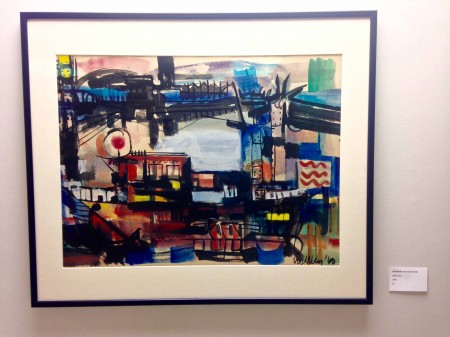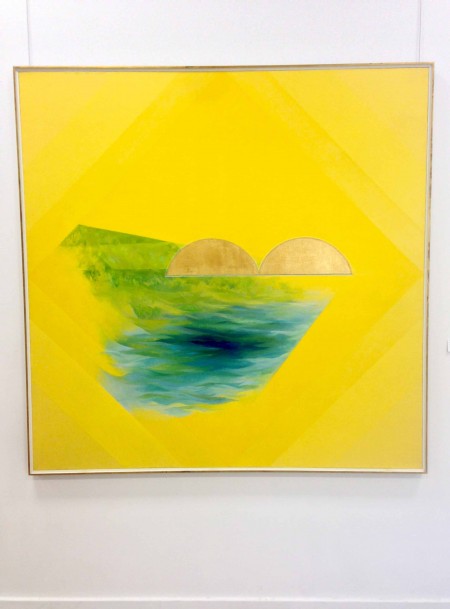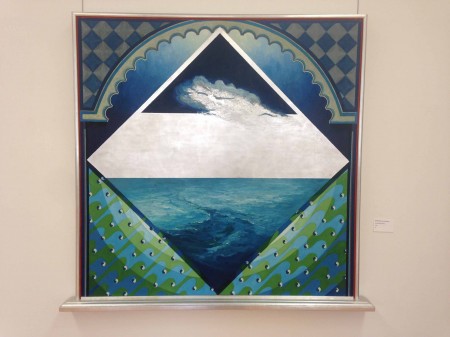A sustained career in the arts—creating new work decade after decade—is always a remarkable achievement. When such a body of work is brought together, we can see the artist’s creative impulse burst open, grow, mature, and, finally, in rare cases, move beyond formal conventions and assumptions about subject matter to reach a truly personal realm. For a brief period, May 17 to May 27, 40 years of paintings by Edward Wolfley, a professor Emeritus at the University of Cincinnati’s DAAP, are on view at the Clifton Cultural Arts Center. The exhibit is thoughtfully arranged and beautifully presented in the spacious galleries of the CCAC. Let me say it outright: do not miss this retrospective of a major Cincinnati artist.
Chronologically, the exhibit begins in the downstairs Emerging Artists Gallery, where 18 paintings from the 1950’s and 1960’s and one from 1971 are on view. The oldest work, “Red Landscape,” is from 1952. By then Wolfley had completed a BFA at the John Herron Art School in Indianapolis and was an MFA student at the University of Illinois at Urbana-Champaign. This stunning painting, oil on masonite, has a dense composition rendered in vivid primary colors; a red building stands out in a landscape of blues, greens, and yellows. As a young artist, Wolfley was part of the Abstract Expressionism movement, but he makes every painting his own. These are the works of a young artist trying to capture the beauty of the world. He is in love with color and works in carefully constructed, detailed compositions. “Cubist Figure” (1955) is sensuous. “Pussy Willows” (1954), in blues, greens, and grays, has an oriental serenity. “Celestial Conflict” (1954) is as close as Wolfley gets to an angry young man abstract, but the dark-against-light painting is more beautiful than angry.

By 1956 Wolfley was an Assistant Professor at UC, where he would teach painting for 33 years until retiring in 1989. Once here, he began painting views of Cincinnati. “Untitled (View of Cincinnati)” from 1960 is an abstract watercolor with all the expected elements–the Ohio, the bridges, the skyline–rendered with great skill. The painting features Wolfley’s characteristic strong lines, dense composition, and brilliant colors. Besides other views of Cincinnati, there are humorous watercolors, “Martini Matrons” (circa 1960) and “Moisten and Apply” (1963). “Mountain Sun” (1961) is a watercolor that resembles Asian calligraphy. These early works give the sense of a young man, attuned to the art of his era but not derivative, proud of his skill as a painter, willing to take on any subject to show what he can make of it. In their considerable variety, these works all express the pleasure the artist takes in the world around him.

Wolfley’s work from the late 1960’s and early 1970’s is displayed in the Lobby Gallery. Nine large oils on canvas are arranged so they resonate with each other. Hung on one side of the room are four large abstracts in beautifully muted colors: “Thunderhole” (1971), “Devil’s Slide” (1973), “Maine” (1969), and “Morning Mist” (1975). Each features large areas of pure color. The compositions suggest the natural world, landscapes with a horizon and submerged depths below. The titles imply the works were inspired by actual places important to Wolfley. These are bold, confident paintings in which Wolfley moves beyond the technical bravado of his earlier work to a more personal, mature view of art and the world. He does not hesitate to make big statements in paintings that are visually appealing but at the same time challenging to viewers.
In the 1970’s Wolfley’s paintings began to exhibit elements that would increasingly characterize his work for the rest of his career. On the long wall of the Lobby Gallery are five monumental oils that create a stunning impression when seen together. In “Shining Big Sea Water” (1975) a broad border of vibrant yellow surrounds a seascape of delicate blues merging to dark blue at the center. Above the waterscape are two half spheres in gold metal leaf, the sun cut in two, casting light above the water. At first the powerful yellow border seems a single color, but, upon closer inspection, diamond shapes can be seen. In this vision of land, sea, and sky, the viewer is drawn into the ethereal beauty of the delicate blue water, set off by the unexpected yellow and the diamond shapes that cradle and protect it. This painting is hung beside “Au Train Entrée” (1975), in which border of dark black and blue surrounds a small rectangle of pale yellow-tan. Again, the viewer is drawn to the center of the canvas, a window opening onto a mysterious realm of light extending beyond the dark that surrounds it. These paintings, based in the natural world we know, seem to be seeking entries into another world we do not yet comprehend.

The Herrick Gallery contains the final works in the retrospective, dating from the late 1970’s to the early 1990’s. In his late work, Wolfley began to shrink the essentials of his compositions to the center of the canvas and surround them with multiple borders of geometrical patterns. The diamond shape dominates many of these works, either as a border or a central compositional element. In the center of these paintings are images of water, the sea, ocean waves. As Wolfley’s work veers toward the Asian, he seems to be searching for something spiritual, essences rather than likenesses. In its title, “Reflections on a Journey” (1984) suggests the journey of life leading to some final passage. The blues, greens, and sliver leaf are the colors of twilight merging into night. The surrounding geometrical shapes give a feeling of order. As in Arabic art, a clear influence on these late works, no representation of the human appears, yet the human soul seems to inhabit the painting. Wolfley lets us know this work could be removed from the wall where it is hung because it rests on a narrow shelf that forms the bottom of the frame.

Wolfley’s efforts to break the boundaries of painting in his later works is not so much a defiance of artistic conventions as a need to follow a deeply felt personal vision. Ironically, by emphasizing the frames surrounding the central image, he demonstrates that a painting is not contained by its borders; it exists in the mind of the viewer. “Departure II” (1984) is a companion to “Reflections on a Journey.” This seascape is surrounded by side panels of diamond and scallop patterns. Wolfley places these panels on a different plane from the middle canvas; by overlapping the central image the panels hide part of the painting. There is more to the painting than we can see. The frame of “Celebration” (1991) divides the canvas into three panels with a diamond in the center. Because it is incorporated into the painting, the frame ceases to impose limits.
Wolfley’s elaborate use of artifice in these late paintings is an acknowledgment that pattern and design can order both life and art. At the same time, he shows us that, though boundaries are necessary, they are not the whole picture; there is a realm within and yet beyond the frame. The dominant natural element at the center of these paintings is water, flowing freely toward a distant horizon, the sea of eternity. Edward Wolfley says farewell to his art with paintings that convey the same exuberance in creation that inspired him at the beginning of his distinguished artistic journey.
–Daniel Burr